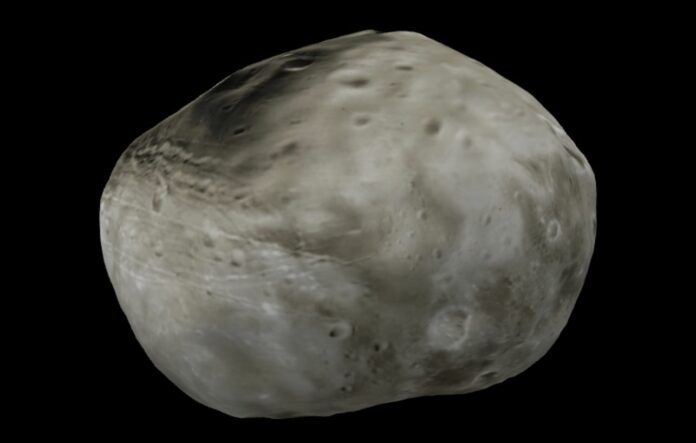Phobos, Mars’ innermost moon with a 22-km diameter, is a cool body. Phobos has parallel linear features on its surface, unlike Deimos. These lines are a unique part of Phobos that don’t exist on Deimos. Since they were first observed in geologic detail by NASA’s Viking missions, over 40 years ago, planetary geologists have been baffled as to how they formed.
Researchers from Tsinghua University, the University of Arizona, Johns Hopkins University, and Beihang University have taken a significant step toward addressing this mystery with a new report published in The Planetary Science Journal. New research suggests these grooves are the surface expressions of canyons buried within Phobos, which are early indicators of the moon’s destruction as a result of growing tidal forces from Mars.
In addition to its peculiar linear markings, Phobos is notable for its proximity to Mars (about 6,000 km), which, according to the effects of tides, is driving it to spiral inward at a rate of around 2 meters per 100 years. Mars is trying to pull it down. Researchers have proposed that these lines are stretch marks, torn by the gravity of Mars, due to the rapid evolution of the planet, which is anticipated to collide with Mars in around forty million years.
But so far, no one has been able to show that such a mechanism for surface tectonics could work. The concept of stretch marks is problematic since it necessitates a relatively stronger outer layer, which cracks when Phobos’s shape shifts beneath it. Even under a gravity less than 1/1000 that of Earth, Phobos’ near-surface porosity of at least 40% makes it appear difficult to sustain networks of significant crevasses in a mass of fluffy dust.
Bin’s team used the most detailed supercomputer simulation models of the problem to date to look into the idea that loose dust sits on top of a sublayer that is somewhat cohesive but weak enough to hold deep cracks. Then, the loose dust runs into the fissures.
“This is the first time,” adds lead author Bin Cheng, “to use millions of particles to explicitly model the stretching and squeezing of granular regolith experiencing tidal evolution. Therefore, we can directly confront the model to observations of grooves on Phobos surface.”
The new models provide a good fit to the currently available observations. If they are right, they can tell us about the early history of Mars if we move them back in time. As they move forward, they can see how Phobos will change as it comes closer.
Bin and his team modeled the upper 150 meters of Phobos’ surface as two rectangular piles of 3 million grains, with the highest 50 meters of grains being highly loose and the deeper grains having a slight cohesiveness. Bin describes it as similar to “a sandwich cookie”. They put these square piles in different places on Phobos to show that the potato-shaped moon is actually an ellipsoid. They used this information to predict the amount of biaxial strain each patch would undergo as Phobos’ innards distorted beneath them in response to the rising tide.
The resulting structures were discovered to have striking parallel patterns and even pitted-to-scalloped-to-linear morphologies, similar to many of the grooves observed around mid-latitudes on Phobos.
Although not all grooves are expected to form in this manner, for those that do, the simulations offer a clear picture of how it happens. As the tidal strain increases, the substrate develops parallel, narrow fractures. This causes weaker material in the upper layer to flow into the deeper fissures, which in turn can form and evolve into intricate groove morphologies, not unlike crevasses emerging on a deforming glacier, except here they form in dry dusty regolith, in microgravity, over tens of millions of years.
The model needs a sub-layer with a cohesiveness of at least 1 kilopascal in order to produce parallel grooves. According to Bin, “this value is similar to that of wet sand at a beach. It is hard to imagine a sandy canyon that is 100 m deep and only 10 m wide, but this makes sense when you think about powdery materials in extremely low gravity.”
With a lander, rover, and sample return, Japan’s forthcoming Martian Moons eXploration (MMX) mission, set to launch in the middle of the 2020s, will provide much more information on this mysterious and ultimately transitory moon. When the tides entirely tear Phobos apart in 20 to 40 million years, it will de-orbit, creating a ring that might make Mars the brightest planet in the Earth’s sky. According to the current research, the surface grooves and underlying canyons are the first indications that this decline has already started.
“We’re lucky to be around now, to see it at all,” adds Erik Asphaug, who participated in the analysis.
As the new theory goes, Phobos is a fragile world where the landscape is constantly changing due to the opening and reworking of granular fissures and the draining of loose material into those fractures, which will finally cause the entire moon to shatter.
Even though this slow destruction is definitely sad, it could also be an opportunity. Caverns that are at least 100 meters deep could give us new places to look for water and other resources around Mars. But we would have to be careful about how weak the walls would be, and we would have to protect our equipment and supplies from the radiation, heat, and cold of space. In another way, the opening of fractures could be good for exploration because it would cause vibrations that could be used for seismology. With seismology, a future mission could map out the interior of the whole moon and learn how it formed in the first place.
Image Credit: NASA
